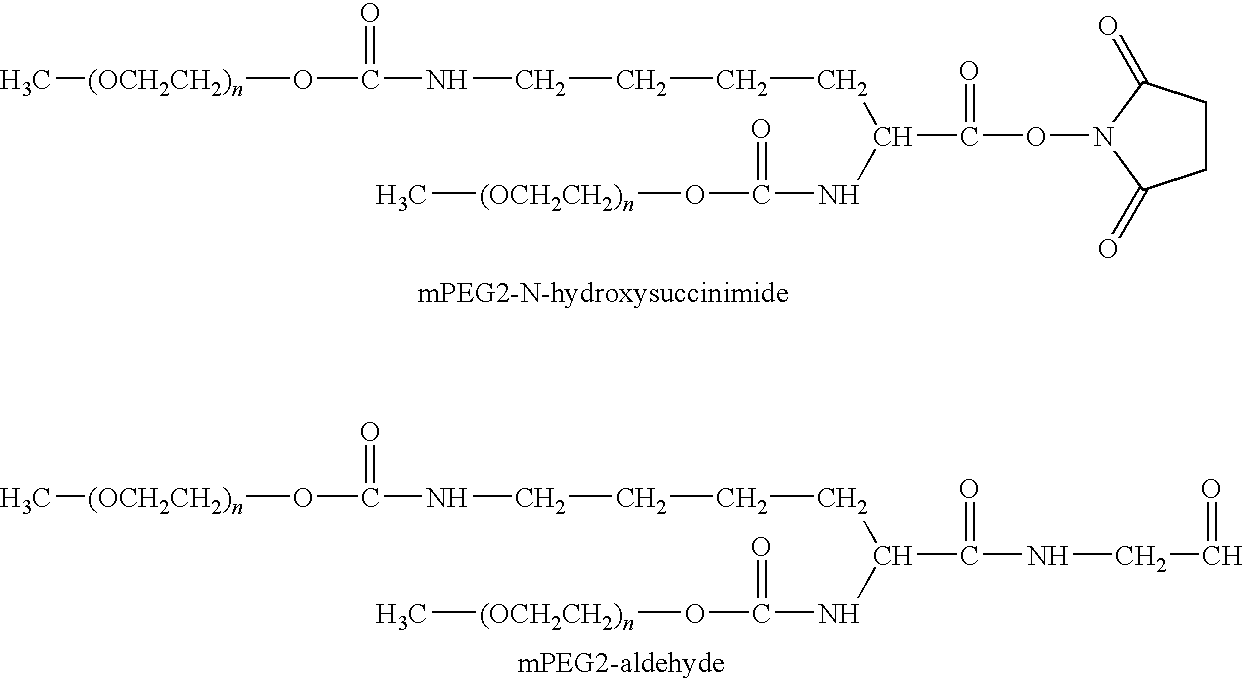Segmented Degradable Polymers and Conjugates Made Therefrom
a technology of degradable polymers and conjugates, which is applied in the directions of powder delivery, pharmaceutical non-active ingredients, and pharmaceutical delivery mechanisms, etc., can solve the problems of limiting the access to ligands required for pharmacologic activity, difficult conjugation of polymers to active agents, and inability to fully metabolize polymers
- Summary
- Abstract
- Description
- Claims
- Application Information
AI Technical Summary
Benefits of technology
Problems solved by technology
Method used
Image
Examples
example 1
4-ARM-PEG(20 KDa)-Mono-Butanoic Acid Having Three Arms with Disulfide Bonds
[0226]A. Pentaerythritol Ethoxylate-Mono-PEG(5 KDa)-Butanoic Acid, Methyl Ester
[0227]A solution of pentaerythritol ethoxylate (3 / 4 EO / OH) (25 g, 0.370 OH equivalents), in toluene (100 ml) was azeotropically dried by distilling off toluene under reduced pressure. The dried pentaerythritol ethoxylate was dissolved in anhydrous acetonitrile (100 ml) and anhydrous pyridine (4.2 ml) and disuccinimidyl carbonate (9.5 g, 0.037 moles) were added and the mixture was stirred overnight at room temperature under argon atmosphere. Next, PEG(5 KDa)-α-amine-ω-butanoic acid, methyl ester (20 g, 0.0040 moles) and triethylamine (1.5 ml) were added and the reaction mixture was stirred overnight at room temperature under argon atmosphere. The solvent was distilled off under reduced pressure. The crude product was dissolved in dichloromethane (20 ml) and then isopropyl alcohol (700 ml) was added at room temperature. The precipita...
example 2
Trilysine Based 4ARM PEG
[0241]A. Trilysine based 4ARM-Benzyloxy-PEG(20 KDa)-Acid
[0242]Trilysine (1.0 g, 0.00151 moles) was dissolved in 100 ml of 0.1 M borate buffer and the pH was adjusted to 8.5 with 0.1 M NaOH. To the resulting solution was added BnO-PEG(5 KDa)-BTC (Nektar Therapeutics, 40.0 g, 0.00800 moles) over 30 minutes and the pH was kept at 8.5 by addition of 0.1 M NaOH. After stirring the resulting solution for 3 h, NaCl (10 g) was added and the pH was adjusted to 3.0 with 10% phosphoric acid. The product was extracted with dichloromethane and the extract dried over MgSO4. Next the solvent was distilled off under reduced pressure. The wet product was dried under vacuum to yield 39.5 g of product as a white solid. HPLC analysis showed that the product: tetra-N-PEGylated trilysine (MW about 20 KDa) was 86.4% pure and was contaminated with high molecular weight (3.1 wt %) and low molecular weight (10.5 wt %) side products.
[0243]The product was purified by ion exchange chroma...
example 3
4ARM PEG(20K)-Mono-Butanoic Acid having One Disulfide Bond
[0254]A. PEG(5 KDa)-α-Succinimidyl Carbonate-ω-Butanoic Acid, Methyl Ester
[0255]A solution of PEG(5 KDa)-α-hydroxy-ω-butanoic acid, methyl ester (58.8 g, 0.0.0118 moles), in toluene (500 ml) was azeotropically dried by distilling off toluene under reduced pressure. The dried product was dissolved in anhydrous acetonitrile (300 ml) and anhydrous pyridine (1.52 ml) and disuccinimidyl carbonate (3.92 g, 0.0153 moles) were added and the mixture was stirred overnight at room temperature under argon atmosphere. The solvent was distilled off under reduced pressure. The crude product was dissolved in dichloromethane (100 ml) and then isopropyl alcohol (1500 ml) was added at room temperature. The precipitated product was filtered off and dried under vacuum giving 57.0 g of white solid.
[0256]NMR (CDCl3): 1.82 ppm (q, CH2—CH2—COO—, 2H), 2.34 ppm (t, —CH2—COO—, 2H), 2.77 ppm (s, —CH2CH2—, succinimidyl, 4H), 3.58 ppm (s, PEG backbone), 4....
PUM
| Property | Measurement | Unit |
|---|---|---|
| molecular weight | aaaaa | aaaaa |
| molecular weight | aaaaa | aaaaa |
| molecular weight | aaaaa | aaaaa |
Abstract
Description
Claims
Application Information
 Login to View More
Login to View More - R&D
- Intellectual Property
- Life Sciences
- Materials
- Tech Scout
- Unparalleled Data Quality
- Higher Quality Content
- 60% Fewer Hallucinations
Browse by: Latest US Patents, China's latest patents, Technical Efficacy Thesaurus, Application Domain, Technology Topic, Popular Technical Reports.
© 2025 PatSnap. All rights reserved.Legal|Privacy policy|Modern Slavery Act Transparency Statement|Sitemap|About US| Contact US: help@patsnap.com



